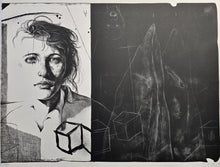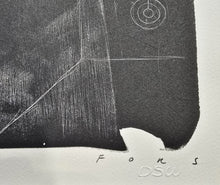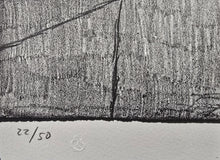This is a large and exceptionally fine etching by this great artist, in very good condition. These are impossible to find.
"The expression of facial psychology has rarely been achieved with the detailed realism of Fors. With Renaissance precision, he shows us what cannot be photographed, the spiritual state of suffering that our faces and expressions hide, the obscure realm of sentiment, the abysses of the heart, the desperate lonliness that destroys us"... Humberto Saldana.
This exquisite etching is typical of the kind of raw power Fors infuses into his work. This print was done in Guadalajara, Mexico, where Fors currently resides.
Born July 30, 1958 in Havana, Cuba. In 1967 his family moved to Mexico City, where he spent the last part of his childhood. He spent his adolescence in Guadalajara, Jalisco. In 1990, Carlos Avilez and José Fors founded the musical group CUCA, which performs irreverent rock and hard rock songs, forming part of one of the most recognized bands of these genres in Mexico.
In 2004, the University of Guadalajara published the book José Fors 25 Years, accompanied by a major retrospective exhibition at the University’s Museum of the Arts. Since 1991 he exhibits annually in his studio. With more than 63 solo exhibitions, 42 group exhibitions around the world, more than 20 recorded albums and a career of 30 years in the CUCA group, José Fors has become a benchmark of tapatío art, receiving countless awards and recognitions. Today, Fors works in Zapopan, Jalisco where he lives with his wife and son Jack.
His first single exhibition was at the Virginia Miller Galleries, Miami, Florida in 1979. He has had notable exhibitions from Miami, Florida to Washington, DC to Boston, Massachusetts to Winnipeg, Canada to Tokyo, Japan to Guadalajara, Mexico.
His work is in the permanent collections of:
Blanton Museum of Art, in Austin, Texas
San Antonio Museum of Art, in San Antonio, Texas
Wurth Museum, in Kunselsau, Germany
Museum of Art at the University of Guadalajara, Mexico
Mexican Fine Arts Center Museum in Chicago, Illinois
National Museum of Fine Arts in Cuba
Houston Museum of Fine Arts
Los Angeles County Museum of Art, California
Museum of Arts in Fort Lauderdale, Florida
Museum of the Americas, Nicaragua
Photographic Library of Pachuca, Mexico
Museum of Contemporary Arts in Los Angeles, California, among other important institutions.








